West Point Worker Placement: Academy Review
By Phil Bolger
Most folks know NDNG as a source for all things wargame– especially our coverage of miniatures wargaming like Team Yankee, Flames of War, Bolt Action, and Blood & Plunder— but today, I’m going to review something a little different. Academy: The West Point Board Game is, in no reasonable sense, a wargame– but the topic it covers, life as a cadet at the United States Military Academy, is certainly an important part of many American military leaders.
Full disclaimer: I am a USMA graduate (H-3, Ride the Storm!), so understand that my view is heavily colored by the type of esprit de corps one can only get from a lifetime of trying to justify four years of grey-colored misery, and I will not apologize for that. The other thing is that the game isn’t out yet– it’s on Kickstarter as of writing, so I’m playing the game on Tabletop Simulator (where it is available for free, minus the cost of Tabletop Simulator). As a result, I have no comments at the time of publication on component quality.
Before I get into the game itself, I want to take a note to highlight the artwork. The attention to detail (an important trait for any USMA cadet) conveys a lot of the iconic images of West Point– Thayer Hall, Michie Stadium, and the Plain (the Parade Ground) are all on the board, and individual cards feature a lot that will be familiar to anyone who attended USMA. It’s done in a cartoon style that I liked.
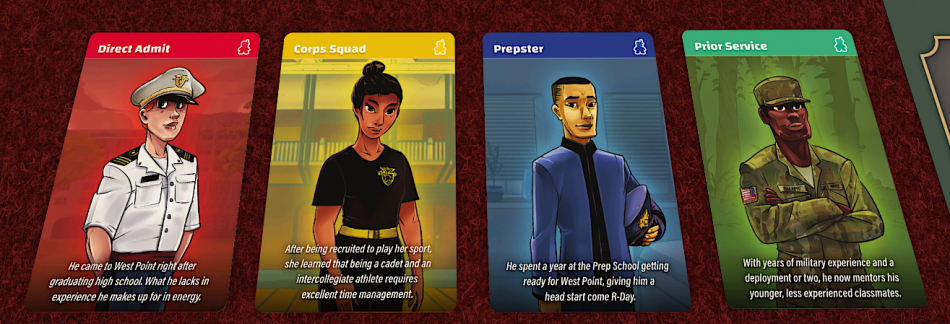
Gameplay is relatively simple, allowing for streamlined play (After some learning games, I was able to finish with three players in 45 minutes), consisting of four years, each representing the four years at USMA. Your goal, during that time, is to amass the most points in each of the three pillars: Academic, Physical, and Military. The board is set up so that there are three locations for each pillar.
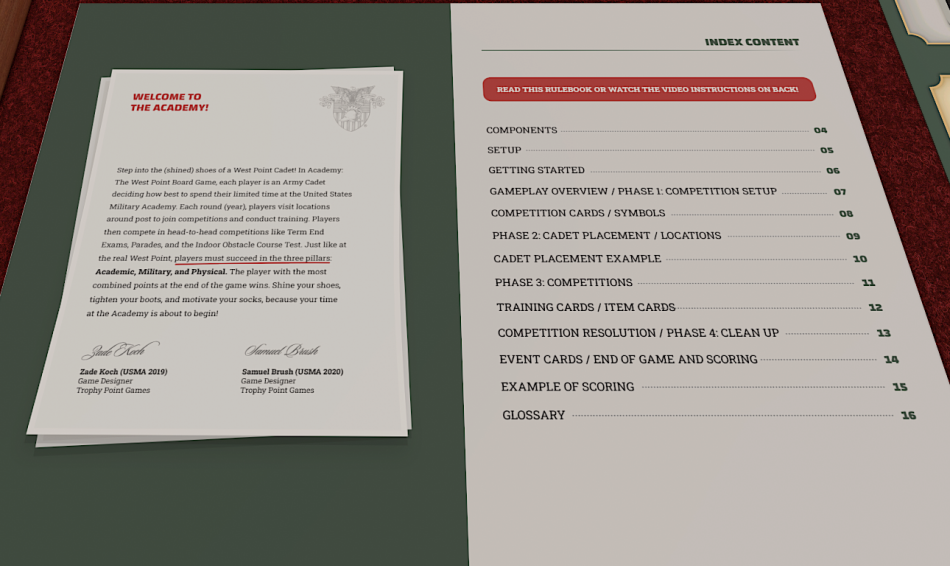
The three Physical locations are Daly Field (a practice field down near the Hudson River), Michie Stadium (home of the Black Knights), and Arvin Gymnasium (the location of the dreaded Indoor Obstacle Course Test, or IOCT).

The three Military locations are: Cadet Barracks (I lived in Bradley Barracks as a plebe, MacArthur Barracks as an upperclassman), Camp Buckner (location primarily used for summer training), and the Plain (the parade ground– a constant fixture in most cadets’ lives, though some athletes didn’t have to attend drill).

The three Academic locations are Jefferson Hall (the library, named for the President who founded West Point), Washington Hall (the Mess Hall, but with classrooms for foreign languages, Geography and Environmental Engineering, and Military Instruction upstairs), and Thayer Hall (the main Academic building, and home of the History Department).

For each of these pillars, the first location is a way to generate new training cards, which can help you in competitions. Here’s a sample hand of training cards.

The second two are locations you’ll need to go to complete competitions, though depending on the player count, they may not all be filled. There are two important factors with each competition– who has played the highest value training cards, and who is first in “line,” meaning which color is closest to the top of the card. In this picture example, Red is “first” in line, giving him one victory point in the Military pillar.
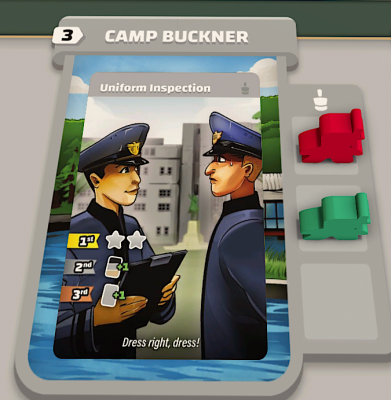
Players take turns placing cadets until all the cadets are on the board, then the competition phase begins. Each competition phase is resolved by playing up to three training cards– it may be tempting to play your strongest training cards at once to grab the victory points, but doing so may leave you with a weak hand for a later competition. In addition, many of the second and third place rewards involve drawing new cards, meaning a player that starts disadvantaged when the competition phase begins may enter the last competition holding a formidable selection of training cards.
Each turn also has an event card, which takes a name from and gives an effect based on events in a West Point cadet’s career. The events help vary the game. These events are set up at the beginning of the game, giving players time to plan.
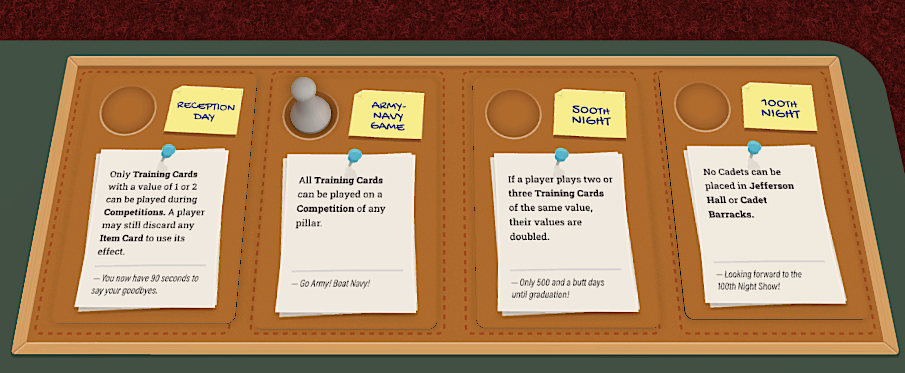
After four turns of placement, then competition resolution, the game ends. Scoring is relatively simple: you add your three pillars together, then award bonus points. The cadet at the top of each pillar gets an additional three points. In a three or four-player game, the cadet at the bottom of each pillar loses three points. If there’s a tie, the tiebreaker is whoever has more training cards in their hand.
If that’s still tied, the game recommends a pushup contest, which made me chuckle. I am a little disappointed there are no rules reflecting the Goat (minus a rating on the “How did you do?” scale in the scoring portion of the rulebook)– traditionally, the person who graduates last at West Point is called the Goat, and on graduation day, every cadet gives the Goat a dollar. With the average class in the past twenty years having around one thousand graduates, that’s not a bad payday for barely making it through.
I enjoyed playing this game, although at least part of that is my own nostalgia. Most people don’t enjoy West Point. It’s an arduous four years of challenge after challenge–but it’s something every graduate is proud of doing. It’s much nicer experiencing USMA with a beer in hand.
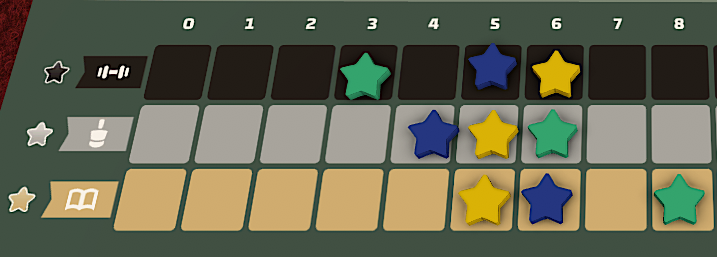
As far as gameplay mechanics go, the gameplay is smooth and the various mechanics play well together (place smartly, use training cards to win competitions, and strive for the best place in class while dealing with the effects of events). This is a family weight game and should be easy to teach to folks who do not normally play heavy board games, as well as children who are looking to learn.
Now, the downsides. My biggest disappointment with this game is the lack of a solo or cooperative variant. While I know that’s challenging to build into a worker placement game, one of the common aphorisms at USMA is “Cooperate to graduate.” While the game is light enough to play quickly and, in my playthroughs, did not garner much animosity between players, I still would’ve liked to see a way to play this game solo or a way to play with some of my friends who would rather cooperate to graduate. All the same, I don’t consider the lack of these features a dealbreaker.
There’s also just not a lot new here. I don’t think this game is particularly innovative compared to other worker placement games I’ve played since it relies on many staples I’ve seen before (first placement/passive aggression/blocking, cards as player interaction, etc). This isn’t enough for me to dislike the game, but I also love the theme. For someone who doesn’t care about West Point, and has played a lot of worker placement games, this game may not add much.
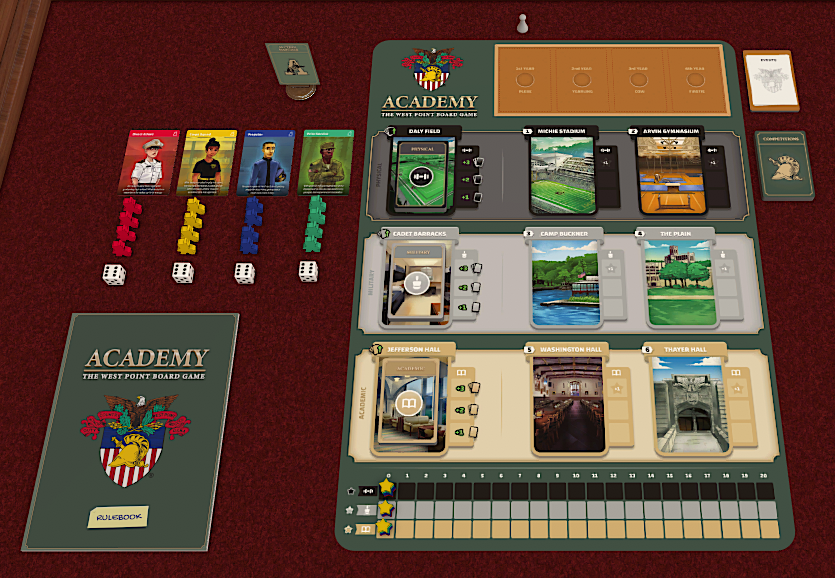
I’ll end by saying that I think this is a competent worker placement game with a theme I really like. Gamifying West Point is fascinating to me, and I think Zade and Sam have done a pretty good job of doing that. For two first-time game designers, this is an extraordinary effort, especially sourcing all the artwork, securing a license from USMA, and bringing the game to crowdfunding– all while they’re still junior officers in the US Army. If this is their first effort, I cannot wait to see what they do next. Overall, I would recommend this game if:
1. You’re looking for a fun game with your family that can introduce them to West Point
2. You or someone close to you went to West Point
3. You want a solid worker placement that still has a theme adjacent to the practice of the military art
On a ten-point scale, I’m happy to give Academy an 8. It’s a good game, and I’m looking forward to getting my physical copy.
